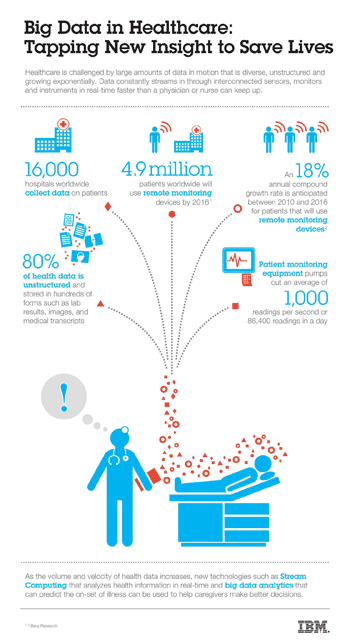Gene Supercomputer Supports Largest Biomedical Research Enterprise in Poland
By LabMedica International staff writers
Posted on 23 Apr 2013
A gene supercomputer has been designed to help bridge the gap between the laboratory and medical practice, gathering and processing biomedical Big Data.Posted on 23 Apr 2013
A new supercomputer in Poland will help scientists process up to 16 terabytes of Big Data per one sequence by running compute-intensive simulations at the speed of 209.7 trillion operations per second. The supercomputer will use algorithms that go beyond the routine sequencing of human or animal genomes, to tackle more complicated processes that should reveal the rare variants in human genetics, i.e., those that cause predispositions to Alzheimer’s disease, cancer, diabetes, and Down’s syndrome. By determining what prevents protein molecules, which help build and maintain human bodies, from folding up correctly and triggering pathologic processes, scientists will be able to develop a new drug or treatment.

Image: ICM's new IBM Blue Gene/Q, code named Nostromo, will help scientists process up to 16 terabytes of Big Data per one sequence by running compute-intensive simulations at the speed of 209.7 trillion operations per second. The supercomputer will use algorithms moving beyond the "routine" sequencing of human or animal genomes, to tackle more complex processes that will reveal the rare variants in human genetics (Photo courtesy of PRNewsFoto/IBM).
The IBM (Armonk, NY, USA) Blue Gene/Q, code named Nostromo, the most powerful single architecture supercomputer in Poland, has been chosen by the Interdisciplinary Center for Mathematical and Computational Modeling, University of Warsaw (ICM; Poland) to support the Poland’s largest biomedical and biotechnological research initiative called the Center for Preclinical Research and Technology (CePT).
More than 500 life sciences and biomedical researchers, physicians, and students, from a consortium led by the Medical University of Warsaw (WUM; Poland) and consisting of three universities and seven research centers of the Polish Academy of Sciences, will use the supercomputer and its supporting e-infrastructure to gain additional insights into chronic diseases. “CePT, a EUR 100-million project, aims to support Poland’s transition towards more preventive and patient-centric healthcare,” said Dr. Robert Sot, director of CePT, Warsaw University. “The project will allow the medical community to provide a more holistic approach and open collaboration for the development of innovative treatments and drugs that will improve patients’ quality of life over the long-term.”
Early detection and timely diagnosis of chronic diseases such as cancer, diabetes, heart disease, stroke, and respiratory and neurologic disorders translate into well-targeted and optimized healthcare, as well as improved quality of a patient’s life. Similar demands could stimulate the need to performed clinical and preclinical tests covering three to five million Polish citizens, and generate massive volumes of critical health data, which then can be used by laboratories.
“The process of developing and generating a new drug or treatment normally takes up to three years, and costs have nearly quadrupled in the past 15 years,” said Prof. Marek Niezgodka, director of ICM. “With Nostromo, we expect to increase the simulation speed which will bring us much closer to the era of personalized medicine, when preventative approaches can be tailored to a specific condition.”
Nostromo has already been installed by IBM Poland and Qumak SA, IBM’s business partner. “IBM delivered the most powerful single architecture supercomputer for the ICM of Poland. Nostromo is able to process up to 16 TB of Big Data per one sequence by running simulations at the speed of 210 TFLOPS [1012 floating-point operations per second],” said Ales Bartunek, country general manager, IBM Poland and Baltics. “We are confident that the POWER based Blue Gene/Q has the potential to save years of research and help scientists take healthcare in Poland to the next level.”
The IBM Blue Gene/Q system, based on POWER architecture, currently ranks 143 on the Top500.org list and 9 on the Green500.org. Its ability to process Big Data is helpful for the faster isolation and analysis of genes and proteins, responsible for the most common chronic lifestyle diseases. It can also be used to simulate new drug development. The supercomputing’s drug modeling, integrates mathematics, physics, chemistry and biology with advanced, high performance computing and engineering and has the potential to significantly reduce a new drug’s time to market by developing new procedures of drug design.
Blue Gene/Q (BG/Q) is the next strategic step towards developing technologies and architectures for exascale-capable computing systems. Effectiveness is one of the most key issues facing ultrascale computing. As the number of processing elements continues to grow, those elements must show a comparable increase in effectiveness to deliver a productive and useful platform. As with the earlier versions of Blue Gene, the reliability of a machine at this scale will be unparalleled.
The BG/Q design continues the legacy of its earlier two Blue Gene generations, providing unparalleled power efficiency. The Nostromo supercomputer is the most energy efficient supercomputer in Poland.
Related Links:
IBM
University of Warsaw
Center for Preclinical Research and Technology














